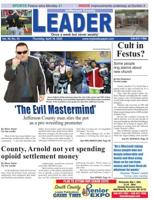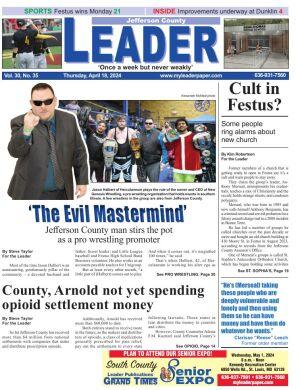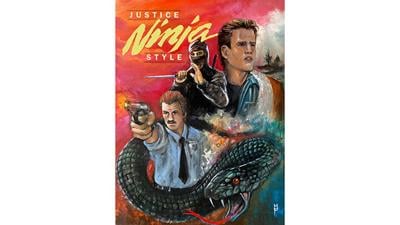Those who lived in De Soto in 1986 may remember a low-budget movie filmed there called “Justice Ninja Style.”
The film was shot over the course of two weeks at several locations around De Soto, and about 100 people from the area were extras in the film.
On April 1, the 70-minute film was re-released, with bonus features added, on Blu-ray disc, which is being sold for $27.99 at vinegarsyndrome.com/collections/frontpage-partner-labels/products/justice-ninja-style.
In case you haven’t heard of the flick, it tells the story of a young man who moves to De Soto to start a karate school and jogs down the wrong road at the wrong time and ends up being framed for a murder.
A ninja, played by Ron D. White of Fenton, who also wrote and produced the film, witnesses the murder. He never shows his face and doesn’t speak but helps the man who was wrongly accused of the murder.
Dan Kinem of Erie, Pa., is behind the new release. He owns VHShitfest, a partner company with Vinegar Syndrome, and has been “uncovering and releasing movies on video” to Blu-ray.
The goal is to showcase the “most unique, crazy and obscure movies that they’ve discovered through years of collecting VHS, allowing even more people to actually be able to experience these nearly lost gems in the best versions possible,” according to the VHShitfest website.
Kinem said it took him five years to track down the film.
He said he is a ninja fan, adding that the mid-1980s were a great time for low-budget, martial arts action films.
Kinem also said he likes obscure, regionally made movies “where an entire town got together and worked on it.”
According to the sleeve of the Blu-ray disc, “‘Justice Ninja Style’ was filmed in De Soto, Missouri, on a tiny budget but had the entire town passionately behind it helping make it. The result is one of the most entertaining ninja movies ever made. VHShitfest is proud to present this soon to be cult classic for the first time on disc.”
The new bonus features include a 58-minute interview with White called “The Ninja Speaks: The Story of Ron D. White documentary.”
“He talked about his early life as a boxer, his life in the Navy, then his martial arts career,” Kinem said. “He won many championships and had a very interesting and unique life. He tells all about the production of the film, his life as a private detective.”
In the documentary, White says he worked out with Elvis Presley at Kang Rhee’s studio, cut the ribbon for the debut of the Six Flags’ Ninja ride, was a four-time world heavyweight champion in kickboxing and retired at age 60 after winning his final fight.
He also said he retired as a private investigator about five years ago after 30 years in the business.
Why De Soto?
White said after he wrote the film and got ready to make it, he spoke with Transcontinental Pictures Raleigh Studios about the costs of shooting the movie in California and learned it would be expensive.
He settled on making it in a small town, De Soto, where his brother, Arvil, lived.
White said the movie was shot at the Police Department, Fire Department, City Hall, restaurants, homes and parks for free.
“It didn’t cost the studio a nickel,” he said.
White said he doesn’t remember what the budget for the film was, but he said it couldn’t have been more than $30,000, with most of the expenses related to “putting the film together.”
He said he received a flat fee for the movie, the extras were paid $1 each and the actors with multiple lines received small fees, mainly agreeing to work on it for the movie credit.
Auditions for the extras in the film were held in the De Soto school gym with about 300 turning out, according to news reports from the time.
“It was a lot of fun,” White said. “People were so cool about it. They were all excited about a movie being shot in De Soto.”
He said the part in the movie where he, as the mysterious ninja, jumps between buildings was shot behind City Hall and he only had to jump 6 feet, even though it looks like a greater distance.
When the film was finished, it had a limited release in the St. Louis area, but it was sold to people in a lot of other countries where those kinds of movies were popular, White said.
However, he said he didn’t know how many copies of the movie were sold over the years because he didn’t profit from it. He said after the initial release, the studio suggested he do an extended cut explaining why the ninja was in De Soto.
“They were 100 percent right,” he said, adding that the new movie makes sense and answers that question.
White
White said he appeared in a few low-budget movies, but never got the bug to pursue a full-time career in the industry.
“I never thought I’d like to be a big movie star,” he said, adding that his focus was on martial arts. “I always wanted to be the champ.”
White, from north St. Louis, said he began boxing when he was 9. Before joining the Navy at 17, he said he had 123 amateur fights, losing 75 of those.
He said while he was in the military, he met an officer who was into karate and mistakenly asked the officer if he wanted to spar. White said he was knocked down with a spinning hook kick and then a spinning back fist.
“I was impressed,” he said.
And that’s how White got into martial arts.
White said after he got out of the military, he found a karate studio and didn’t miss a day there, quickly becoming a brown belt and then a black belt.
He said he developed an interest in Ninjutsu in the 1980s and began working on those skills.
Back to the movie
Kinem said he visited with White in De Soto, touring film locations and the
De Soto museum, where some movie props and costumes are housed.
He said everyone he and White ran into “of a certain age” had a connection to the film, remembering it coming out or having a family member or friend who was an extra in it.
Locals reflect on the film
One of the Blu-ray bonus features is audio commentary from De Soto natives Cody Terry and Steven Francis.
Terry said he remembers the film crew shooting the movie.
“I was born and raised in De Soto,” he said. “Around 1986, a film crew arrived in town to shoot a movie. This was big news. De Soto was a small town, with its biggest claim to fame being a long one-sided main street and at one time being the population center of the United States.”
He admits most De Soto residents at the time expected the film to be more like a Hollywood production so there was some let-down when the amateur production was released.
“The movie was distributed mostly in the Jefferson County area, on VHS,” Terry said. “You could check out a copy at the De Soto Public Library, which is how I first watched it.
“From the opening scene that featured a bird’s eye view of Main Street, it was amazing to me to see our little town on screen. They passed my driveway! The Ninja is fighting the bad guys in Spross Park! It was really neat to this 7 year old.”
Terry said throughout the years, the movie has held a dear place in his heart. Due to its limited distribution and VHS format, he said it became difficult over the years to find a copy.
“A few years ago, a friend of mine, Jay Burch, told me he had an original copy of the VHS,” Terry said. “He loaned it to me. Over the next few years, I shared the film with people I met on movie groups on Facebook. Everyone seemed to enjoy it.”
And then earlier this year Kinem contacted him.
“I was familiar with Dan through a documentary he had done titled ‘Adjust Your Tracking’ that covered rare and obscure VHS tapes that didn’t make the transition to DVD,” Terry said. “Dan had seen ‘Justice Ninja Style’ and was planning to release it through his label VHShitfest, partnering with Vinegar Syndrome.
“He asked if I could do the commentary track on the Blu-ray, as he thought it would be fun to have a local and a fan do it. I recruited my good friend and fellow B-movie aficionado Steven Francis to help me out, and we discuss fun facts, locations and tidbits about De Soto throughout the film. It’s really cool for Dan to make this happen, and it’s exciting to finally see this low, low budget movie get a wider release so others can enjoy it.
“What I enjoy about these kind of, let’s be honest, no-budget films, is that it takes a vision and a lot of work. You can tell they were trying their best, and I think that is pretty admirable. A lot of people have dreams, but they are scared to pursue them. These guys went for it, and that Blu-ray has sold over 1,000 copies in a month. It makes me feel good for everyone who put in the effort.”
A DVD copy of the original flick, not in high-definition and without the bonus features, is available to rent at the De Soto Public Library.





